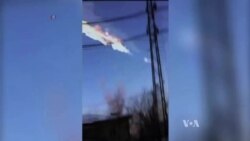Last year, a meteorite exploded 23 kilometers above Chelyabinsk, Russia.
It was estimated to be 18 meters long with the mass of about 10,000 tons. If it had fallen in a populated area, an entire city could have been devastated. Luckily, the meteorite disintegrated and most of the fragments fell into Lake Chebarkul.
Space rocks often enter the Earth’s atmosphere and usually explode and burn before falling to the ground. About 70 percent of our planet is covered with water so most of them disappear beneath the oceans’ surface.
The Comprehensive Nuclear-Test-Ban Treaty Preparatory Commission (CTBTO), based in Vienna, Austria, says the Earth is visited by meteorites more often than is widely known.
“Since meteorites are sometimes entering the atmosphere, and they are creating loud air bursts," said acoustic officer Pierrick Mialle. "Then we will record those at some of the stations."
The commission controls a worldwide network of seismic, hydrostatic, ultrasound and radioactivity sensors that monitor possible violations of the Nuclear Test ban treaty. They also document meteor encounters. Between 2000 and 2013, 26 powerful explosions of large meteorites were recorded entering the Earth’s atmosphere.
The B612 foundation, which monitors meteorite impacts, estimates at least four of them were stronger than the nuclear bomb that destroyed Hiroshima.
In addition to loud noise, explosions create low frequency infrasound, out of humans' hearing range, which can travel very long distances.
The February 2013 explosion of the Chelyabinsk meteorite was recorded by CTBTO stations as far as Antarctica.
Mialle says listening stations have an array of four to 15 high-technology sensors.
“They are called micro barometer because they measure micro fluctuations of the atmosphere," Mialle said. "It’s like a large microphone except there’s no membrane.”
Some of the explosions are hard to identify immediately after detection.
“For instance, the first time we had this, what was later called the Super Bolide of North Pacific, in the first few weeks all that was known was a large event in the middle of the Pacific, but we didn’t know what it was,” Mialle said.
The commission keeps contact with other agencies that track meteorites, such as NASA, which later confirmed that the mysterious explosion was caused by a meteorite.
When complete, the CTBTO system will have 337 stations worldwide monitoring nuclear explosions and other loud sounds in the atmosphere.
It was estimated to be 18 meters long with the mass of about 10,000 tons. If it had fallen in a populated area, an entire city could have been devastated. Luckily, the meteorite disintegrated and most of the fragments fell into Lake Chebarkul.
Space rocks often enter the Earth’s atmosphere and usually explode and burn before falling to the ground. About 70 percent of our planet is covered with water so most of them disappear beneath the oceans’ surface.
The Comprehensive Nuclear-Test-Ban Treaty Preparatory Commission (CTBTO), based in Vienna, Austria, says the Earth is visited by meteorites more often than is widely known.
“Since meteorites are sometimes entering the atmosphere, and they are creating loud air bursts," said acoustic officer Pierrick Mialle. "Then we will record those at some of the stations."
The commission controls a worldwide network of seismic, hydrostatic, ultrasound and radioactivity sensors that monitor possible violations of the Nuclear Test ban treaty. They also document meteor encounters. Between 2000 and 2013, 26 powerful explosions of large meteorites were recorded entering the Earth’s atmosphere.
The B612 foundation, which monitors meteorite impacts, estimates at least four of them were stronger than the nuclear bomb that destroyed Hiroshima.
In addition to loud noise, explosions create low frequency infrasound, out of humans' hearing range, which can travel very long distances.
The February 2013 explosion of the Chelyabinsk meteorite was recorded by CTBTO stations as far as Antarctica.
Mialle says listening stations have an array of four to 15 high-technology sensors.
“They are called micro barometer because they measure micro fluctuations of the atmosphere," Mialle said. "It’s like a large microphone except there’s no membrane.”
Some of the explosions are hard to identify immediately after detection.
“For instance, the first time we had this, what was later called the Super Bolide of North Pacific, in the first few weeks all that was known was a large event in the middle of the Pacific, but we didn’t know what it was,” Mialle said.
The commission keeps contact with other agencies that track meteorites, such as NASA, which later confirmed that the mysterious explosion was caused by a meteorite.
When complete, the CTBTO system will have 337 stations worldwide monitoring nuclear explosions and other loud sounds in the atmosphere.









